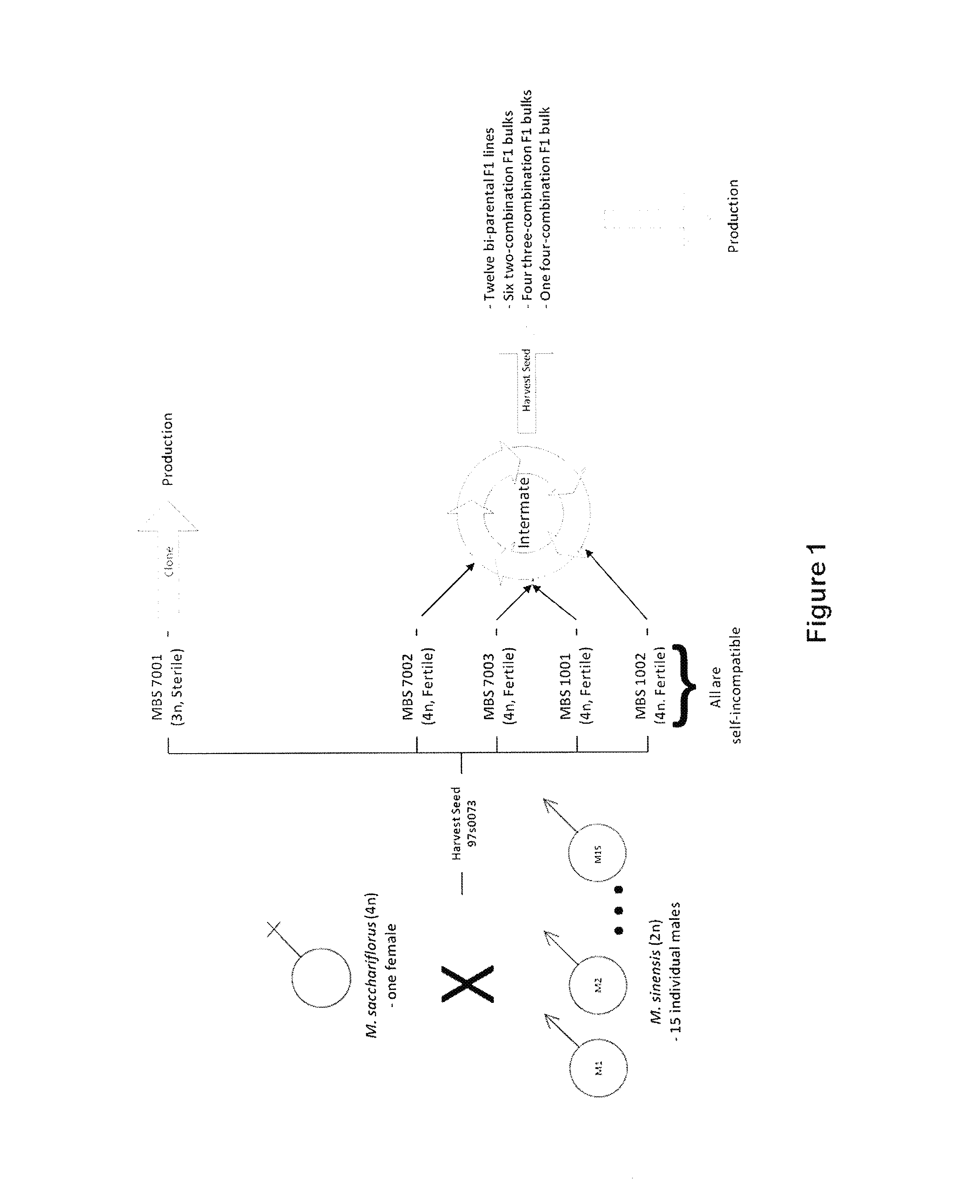High biomass miscanthus varieties
a technology of miscanthus and biomass, applied in the field of high biomass yielding miscanthus varieties or cultivars, can solve the problems of inability to produce seeds, and achieve the effects of improving water deficit tolerance, improving biomass yield, and improving flowering tim
- Summary
- Abstract
- Description
- Claims
- Application Information
AI Technical Summary
Benefits of technology
Problems solved by technology
Method used
Image
Examples
example i
Generation of Novel Miscanthus Lines Via Interspecific Crosses
[0337]Miscanthus varieties were generated by crossing a large-stemmed M. sacchariflorus genotype from Japan (ploidy: 4×) as a female parent with a population of 15 M. sinensis (ploidy: 2×) plants as pollen donors. From this cross (designated 97s0073), 158 seedlings were obtained and planted in a field. Based on field observations, five selections for high-biomass were made, one of which was triploid, and four were FTMG varieties. The left-hand side of FIG. 1 provides a schematic of the breeding process used to create ‘MBS 7001,’‘MBS 7002,’‘MBS 7003,’‘MBS 1001’ and MBS 1002.
[0338]FTMG varieties could also be produced via induced tetraploidy in diploid parents or progenies. Induced tetraploid genotypes can be obtained by doubling the chromosome number of diploid genotypes using published methods (Glowacka et al. (2009). Industrial Crops Products, 30: 444-446; Petersen et al. (2003) Plant Cell Tissue Organ Culture 73: 137-14...
example ii
Morphological and Physiological Attributes of FTMGs
[0341]Morphological Characteristics.
[0342]FTMG F1 plants were more vigorous and taller than either of their M. sacchariflorus or M. sinensis parents. Tiller density (stems / m2) was greater for FTMG varieties than M. sacchariflorus or the M×g ‘Illinois’ clone. The combination of greater vigor and height than parental lines and higher tiller density than M. sacchariflorus or the M×g ‘Illinois’ clone. FTMG varieties thus conferred to the latter plants relatively high biomass. FTMG varieties also flowered later than the M. sinensis parents, a characteristic that contributed to their greater height.
[0343]Improved Seedling Vigor, Cold Tolerance, and Water Deficit Tolerance of FTMG Varieties.
[0344]Miscanthus was evaluated in greenhouses and in field trials at different sites spread across two distinct regions in North American. In these trials, FTMG varieties, and particularly those of the instant invention, demonstrated a number of advanta...
example iii
Improved Yield Produced by FTMG Varieties
[0348]Miscanthus varieties are expected to develop significantly more biomass than many other plants considered as feedstock candidates, including switchgrass. For example, in an experimental field trial conducted in ‘Illinois,’Miscanthus×giganteus yielded approximately twice the biomass as switchgrass.
[0349]Miscanthus varieties ‘MBS 7002,’‘MBS 7003,’‘MBS 1001,’ and ‘MBS 1002’ have also consistently exhibited vigorous growth, a top leaf height of about 2.6 meters, and high tiller density relative to many other Miscanthus varieties. In side-by-side comparisons conducted in Klein-Wanzleben, Germany, Miscanthus varieties ‘MBS 7002,’‘MBS 7003,’‘MBS 1001,’ and ‘MBS 1002’ were more vigorous than either of their parent plants, including with regard to greater seedling vigor than the parent plants, and produced more biomass than either parent. ‘MBS 7002’ and ‘MBS 1002’ had taller culms but demonstrated less lodging; hence they produced stronger culms...
PUM
| Property | Measurement | Unit |
|---|---|---|
| Fraction | aaaaa | aaaaa |
| Fraction | aaaaa | aaaaa |
| Fraction | aaaaa | aaaaa |
Abstract
Description
Claims
Application Information
 Login to View More
Login to View More - R&D
- Intellectual Property
- Life Sciences
- Materials
- Tech Scout
- Unparalleled Data Quality
- Higher Quality Content
- 60% Fewer Hallucinations
Browse by: Latest US Patents, China's latest patents, Technical Efficacy Thesaurus, Application Domain, Technology Topic, Popular Technical Reports.
© 2025 PatSnap. All rights reserved.Legal|Privacy policy|Modern Slavery Act Transparency Statement|Sitemap|About US| Contact US: help@patsnap.com



